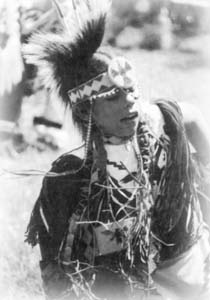![[Metroactive Features]](http://metroactive.com/features/gifs/feat468.gif)
![[Metroactive Features]](http://metroactive.com/features/gifs/feat468.gif)
[ Features Index | Metro | Metroactive Central | Archives ]
Sober Experience
By Jesse Douglas Allen-Taylor
Community festivals are supposed to be safe places to take the family, but all too often they have been overcome by the same sort of violence that has infected much of the rest of American society. A bottle-throwing crowd clashed with police during San Jose's Cinco De Mayo Festival this year, leading to several arrests. The same thing occurred three years ago at Oakland's once-popular Festival at the Lake, and the event has been in decline ever since. In 1992 at the Marin City Festival, a fight between two rap groups, one of them led by the late Tupac Shakur, caused the shooting death of a 6-year-old bystander. At other such festivals, arguments and scattered fist fights are becoming more and more common.
That wasn't the case at the 12th Annual Red Road Pow Wow, a traditional-style Native American gathering held last weekend at the Casa De Fruta Orchard Resort in Hollister and sponsored by the Santa Cruz Indian Council. It was one of hundreds of such pow wows held in the warm months of each year throughout the United States and Canada.
A quiet ease surrounded the Hollister event. Sweet sage burned in several pots. Drummers and singers made their sacred music in the coolness of newly constructed arbors, while hour after hour in the central meadow arena, costumed dancers stamped out ancient steps on the hot grass. Business was heavy and steady at 30 booths and tents selling food and Native American artifacts. The campground surrounding the festival area was like a movable village: hamburgers sizzled on grills, families laughed and talked quietly around portable tables, young lovers stole kisses in the shade of the trees, barefoot children trolled for guppies in a nearby river. A single black hawk hovered like a good omen over the central arena for almost half an hour, as if giving sanction. All seemed at peace.
It hasn't always been like that.
"Twenty-five years ago, you couldn't have gone up into a pow wow camp; it was too dangerous," recalls Vince Harvier of Yuma, Ariz. He is an older man, in his mid-60s, dressed in a spotted Native American shirt and wearing a feathered headdress. He is a "prayer person" which is someone greatly respected among the Indian people, but in status somewhere below the "medicine people," whom Harvier holds in deep reverence. He has attended pow wows for years, and considers them something like ongoing family reunions, a chance to both preserve the old Indian ways and to visit with old friends. "But it was often bad," he says. "There were always fights. And even while we were having our sacred ceremonies inside the arena, people would be on the outside getting drunk. And then there would be trouble."
The trouble ended when the various councils running the pow wows decided to do away with drugs and alcohol at the events.
"We've been emphasizing drug- and alcohol-free pow wows since 1984," Harvier says. The emphasis is evident. The Red Road Pow Wow's brochure declares itself a "celebration of sobriety." Signs are posted all around the campground proclaiming that anyone "caught under the influence" would be removed. (The signs are mostly for tourists and newcomers, Harvier explains. "Indians all know we don't allow it.") A Sunday afternoon ceremony had all the trappings of an Alcoholics Anonymous meeting, with participants coming to the microphone to tell how long they'd been "clean and sober."
There are reasons for the banning of drugs and alcohol in American Indian events that go beyond the wish to lower the level of violence. The National Clearinghouse for Drug and Alcohol Information reports that "American Indians/Native Alaskans die more frequently than members of other ethnic/racial groups from suicide, homicide, and unintentional injuries or accidents, most of which are related to alcohol. These causes, along with cirrhosis of the liver and alcoholism, account for more than a third of all American Indian deaths. For this group as a whole, death rates from alcohol-related causes are more than three times higher than other groups."
Asked how Native Americans can condemn the use of drugs on the one hand while using such drugs as peyote in sacred ceremonies on the other, Harvier says it is similar to how the general society views the difference between illegal and prescription drugs. "The problem comes when drugs are abused or used for improper purposes, such as simply for enjoyment," he says.
"Our attitude used to be that alcoholism was the 'white man's disease,' so let the white man treat it," explains Harvier. "But that didn't work. So now we are substituting the Native American spiritual ways. When someone wants to come into the Talking Circle or the Sweat Lodge or dance in the arena, we tell them that they must be clean and sober. Just for that time. We try to get them to clean themselves up one day at a time."
[ Metro | Metroactive Central | Archives ]
This page was designed and created by the Boulevards team.

Indians celebrate pow wow
with a 12-step beat
From the May 29-June 4, 1997 issue of Metro
Copyright © 1997 Metro Publishing, Inc.